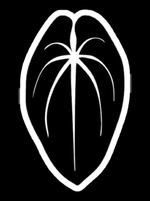
Papillilaminum breeding program
Share
Project Pap: A Vision for Refinement and Excellence
When I started on my Project Pap breeding project, I did not set out to follow specific lineages, though many selections with strong pedigrees naturally aligned with my vision due to their exceptional traits. My primary objective was to refine the aesthetic appeal of Paps by emphasizing unique yet subtle characteristics—such as refined shape, increased vein count, pronounced red veining, deeply pigmented foliage, and striking emergent coloration.
To streamline my selection process, I categorized traits using simple yet effective classifications like “superior” and “inferior” transitions, allowing me to identify and prioritize the most structurally elegant specimens. Fortuitously, the market saw a slight dip in Paps prices during my acquisition phase, affording me the opportunity to curate a highly selective collection. Some specimens were as affordable as $120, while others reached $500, yet each was chosen with precision to align with my long-term breeding goals.
A crucial genetic cornerstone of this project was a black velvet eastern Panama (BVEP) hybrid that had already been crossed for enhanced characteristics. Fortunately, Nick Chew had recently executed such a cross using Round BVEPand a RA Pap. I was able to acquire ten large seedlings from him. From this batch, I meticulously selected the three most vigorous individuals exhibiting the precise traits I sought—particularly dark foliage and 6 well-defined basal veins. Of these, two have become foundational breeders in Project Pap. Paps not pure are labeled.
Another indispensable addition to my program was a selection from Paul Marcellini’s renowned “Swamp Trash” lineage, specifically a Swamp Bunny × Gatorbod . Paul’s meticulous selection work in Pap breeding is unparalleled, and I have no doubt that his influence will manifest strongly in my project. The Swamp Trash specimens I acquired feature nearly black foliage with equally dark emergent leaves, reinforcing the depth of coloration I aim to preserve.
Guna Yala genetics were also integral to my breeding strategy due to their superior form and intricate vein patterns. Their wide smooth face will make any offspring an absolute beauty. It's absolutely pure genes from Panama we're also invaluable in my project.
The RA5 x RA6 is the perfect blend of what Rory's Papillilaminums have to offer. The long shape of the RA6 and the perfect vein pattern of the RA5. The wonderful Bullete surface that cast such a beautiful shadowed look. The vigorous growth pattern of Rory's pure pap cross also shines through.
While I have chosen to document each breeding line with their own batch name rather than by cross names, every plant is meticulously recorded with its parentage for clarity and transparency. Piedmont Pap , Temescal Pap and Oaktown pap. Each cross will have dedicated page for its parents and the thought that went into the choices.
The Project Pap is built not only on superior genetics but also on a commitment to traceability and long-term value. Each plant produced under this initiative will be registered in a live lineage database, ensuring that buyers can verify its origins and maintain its market worth. Though these plants are not pure Paps, they carry the designation due to their dominant genetic influence.
This is only the beginning. With each generation, I anticipate remarkable refinements and breakthroughs, solidifying Project Pap as a defining project in the evolution of Pap cross breeding. The canal pap like Ralph lynam and Fort Sherman will be in future projects.
thank you
Jorge Dominguez
Anthurium Story
